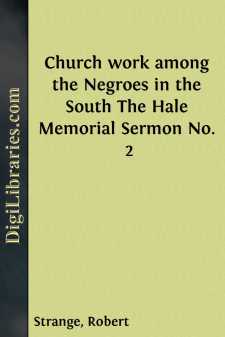Categories
- Antiques & Collectibles 13
- Architecture 36
- Art 48
- Bibles 22
- Biography & Autobiography 813
- Body, Mind & Spirit 138
- Business & Economics 28
- Children's Books 12
- Children's Fiction 9
- Computers 4
- Cooking 94
- Crafts & Hobbies 4
- Drama 346
- Education 46
- Family & Relationships 57
- Fiction 11821
- Games 19
- Gardening 17
- Health & Fitness 34
- History 1377
- House & Home 1
- Humor 147
- Juvenile Fiction 1873
- Juvenile Nonfiction 202
- Language Arts & Disciplines 88
- Law 16
- Literary Collections 686
- Literary Criticism 179
- Mathematics 13
- Medical 41
- Music 40
- Nature 179
- Non-Classifiable 1768
- Performing Arts 7
- Periodicals 1453
- Philosophy 64
- Photography 2
- Poetry 896
- Political Science 203
- Psychology 42
- Reference 154
- Religion 505
- Science 126
- Self-Help 81
- Social Science 81
- Sports & Recreation 34
- Study Aids 3
- Technology & Engineering 59
- Transportation 23
- Travel 463
- True Crime 29
Church work among the Negroes in the South The Hale Memorial Sermon No. 2
by: Robert Strange
Description:
Excerpt
CHURCH WORK AMONG THE NEGROES IN THE SOUTH
I take as the South the eleven old slave states, which stood at one time in armed array against the rest of the United States, which are to-day as loyal and true to the General Government as any other states in this great and favored land of ours. They are Virginia, North and South Carolina, Georgia, Florida, Alabama, Mississippi, Tennessee, Louisiana, Arkansas and Texas. These states make up one-fourth of the area of the United States, and their population is about one-fourth of that of the whole country. These figures and the others that I shall give cannot be exact, as we are so far away from the last census; but they are close estimates, and present, I think, a fair idea of the facts as they are to-day.
In this large section of our country, with only 1.6 per cent. foreign born, the negroes make up 40 per cent. of the population. They are found chiefly in the cities and towns, and in the country along the coastal plains and on the first rise of the hills; we see very few in the mountain districts.
What of the religious affiliations of the negroes? Nearly every negro is a nominal church member. The first reason for this is that his childish emotional nature is essentially religious, fearing or adoring the unseen powers. The second reason is that the Church is not only the religious but the social center for the negro, largely taking the place with him, which the secret and benevolent societies hold among the white people. Very few are Roman Catholics. The Roman Church has not made the progress among the negroes, which one would expect of the Church which has such a hold on the common peoples of Southern Europe. Only about four thousand are members of the Presbyterian Church; and to the Episcopal Church belong only 9,000 communicants. The rest are divided between the Baptists and Methodists. The low educational standard of the ministry for these Churches, their easy methods of organization and their insistence on feeling rather than on conduct have appealed strongly to the great mass of the negroes.
Looking more closely at those in our Church, we find that out of nine million negroes in the South, we have about nine thousand communicants: one in a thousand. They vary from one in 381 in Virginia to one in 7961 in Mississippi. In my own State of North Carolina we have one negro communicant to every 480 of the negro population.
What was the religious condition and teaching of the negroes before the Civil War? In 1816 in Philadelphia the African-Methodist Episcopal Church separated from the whites; and they have formed the strongest negro organization in the country. A large number of the negro Methodists remained, however, with the whites; and for some of these, churches were built, and a white preacher regularly set aside by the white Conference to minister to their black people. Others came to the same church with the whites, occupying the gallery or pews allotted to them in the rear of the Church. The colored Baptists and Presbyterians worshipped in the same way with the whites, and were ministered to by white preachers....


